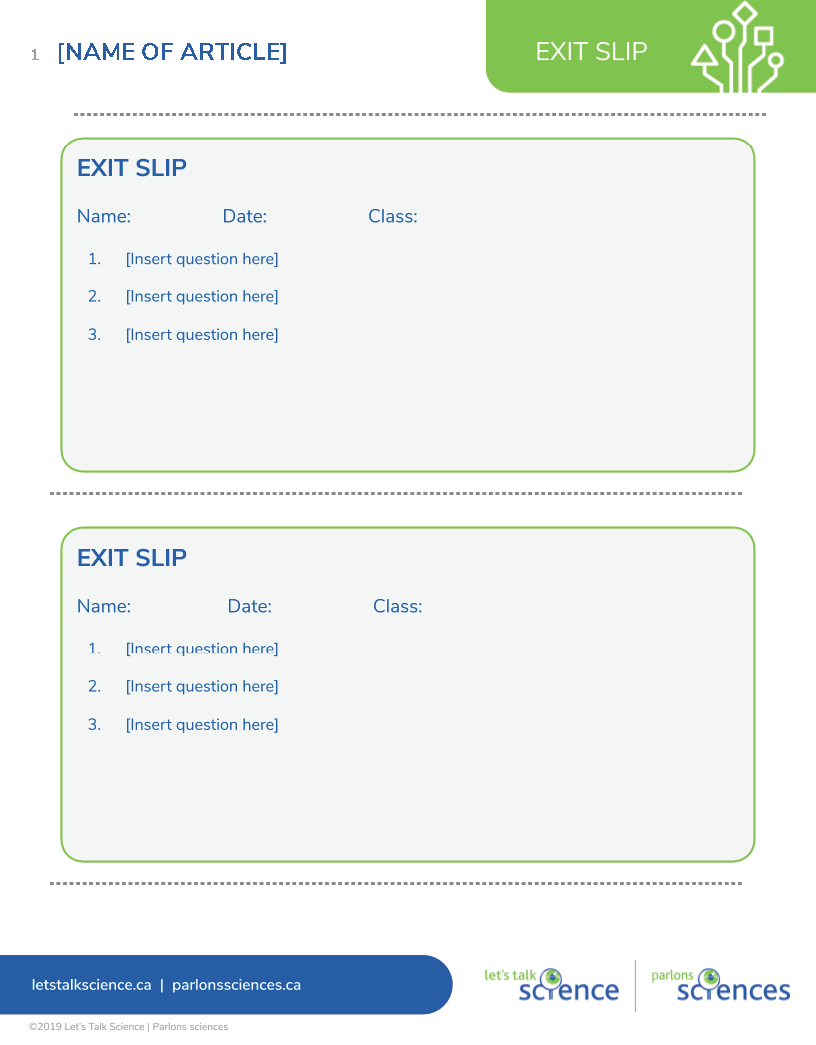Exit Slip

Exit Signs (Francisco Anzola [CC BY 2.0], Wikimedia Commons

Exit Signs (Francisco Anzola [CC BY 2.0], Wikimedia Commons
Format
This strategy helps students reflect on new learning by filling in a type of ‘ticket’ which is used to exit the class
Why use it?
- To reflect or review learning of a new topic of study or discussion
- To assess student learning at the end of a class or lesson
Tips for success
- Prompts could have students:
- Write about something new they learned.
- Write a one- or two-sentence summary of what they learned.
- Identify the three most important things they learned.
- Write about the experience of learning the new material (i.e., how easy or hard it was to learn).
- Self-assess their understanding of the material.
- Write about connections and relevance to other classroom learning.
- Develop questions/statements that are supported or refuted with information that can be found in the text.
- Identify questions which they still have about the topic.
- Anticipate what they still need to learn about the topic and/or what they would like to learn next.
How do I use it?
- Choose an article or video that you want your students to read or view.
- Create an Exit Slip for the given article or video using the Exit Slip Template or use one of the Ready-to-Use Exit Slip reproducibles.
- Prompts can include questions, statements, scenarios, etc. The prompts should be open-ended and allow students opportunities to reflect on their learning.
- Provide each student with a copy of the prepared Exit Slip (note that two copies can be made from one template page) towards the end of a lesson or class.
- Completed Exit Slips can be handed in and used as an assessment of learning.
Variations
- Put the prompts on index cards instead of the Exit Slip template.
- Exit Slips can also be used in different ways:
- Students pair up and share their responses with their partner and discuss their responses.
- Completed Exit Slips are collected, shuffled (Card Shuffle) and then passed out to students randomly. Students read the responses on the card and then provide their input/feedback on the response. This could be repeated several times and then the responses are read out loud to the class to discuss.
- A few of the submitted Exits Slips can be read out loud to the class. By having the students give thumbs up or thumbs down, you can get a general picture of the class’ understanding of the topic or article.
Extensions
- Completed Exit Slips can be handed back at a later date to have the students reflect on their learning after they have gone further in depth with a topic. Students can comment on how their learning/understanding has or has not changed.
Using this Strategy
- Exit Slip Reproducible Template [Google doc] [PDF]
- Can Whales Really Explode?: Exit Slip Reproducible [Google doc] [PDF]
- Can You Store Electricity for Later?: Exit Slip Reproducible [Google doc] [PDF]
- Celiac Disease: When You Really Need to Stay Gluten-Free: Exit Slip Reproducible [Google doc] [PDF]
- How Do We See Colour?: Exit Slip Reproducible [Google doc] [PDF]
- How is Lenz's Law Used in Drop Tower Rides?: Exit Slip Reproducible [Google doc] [PDF]
- The Chemistry of Redheads: Exit Slip Reproducible [Google doc] [PDF]
- The Dating Habits of Archaeologists: Exit Slip Reproducible [Google doc] [PDF]
- The Environmental Impact of Wasted Food: Exit Slip Reproducible [Google doc] [PDF]
- The Genius of Mendeleev's Table: Exit Slip Reproducible [Google doc] [PDF]
- The Hovering Human: Exit Slip Reproducible [Google doc] [PDF]
- The Newest Elements on the Periodic Table: Exit Slip Reproducible [Google doc] [PDF]
- The Wacky History of Cell Theory: Exit Slip Reproducible [Google doc] [PDF]
- Thermopower and the Body Heat-Powered Flashlight: Exit Slip Reproducible [Google Doc] [PDF]
- What Are the Pros and Cons of Nuclear Energy?: Exit Slip Reproducible [Google doc] [PDF]
- What is Fracking? : Exit Slip Reproducible [Google doc] [PDF]
- Where Do Viruses Come From? : Exit Slip Reproducible [Google doc] [PDF]
- Why is Your Doctor So Interested in Your Pee? : Exit Slip Reproducible [Google doc] [PDF]
Create Your Own
- Exit Slip Reproducible Template [Google doc] [PDF]
Ready to Use
- Can Whales Really Explode?: Exit Slip Reproducible [Google doc] [PDF]
- Can You Store Electricity for Later?: Exit Slip Reproducible [Google doc] [PDF]
- Celiac Disease: When You Really Need to Stay Gluten-Free: Exit Slip Reproducible [Google doc] [PDF]
- How Do We See Colour?: Exit Slip Reproducible [Google doc] [PDF]
- How is Lenz's Law Used in Drop Tower Rides?: Exit Slip Reproducible [Google doc] [PDF]
- The Chemistry of Redheads: Exit Slip Reproducible [Google doc] [PDF]
- The Dating Habits of Archaeologists: Exit Slip Reproducible [Google doc] [PDF]
- The Environmental Impact of Wasted Food: Exit Slip Reproducible [Google doc] [PDF]
- The Genius of Mendeleev's Table: Exit Slip Reproducible [Google doc] [PDF]
- The Hovering Human: Exit Slip Reproducible [Google doc] [PDF]
- The Newest Elements on the Periodic Table: Exit Slip Reproducible [Google doc] [PDF]
- The Wacky History of Cell Theory: Exit Slip Reproducible [Google doc] [PDF]
- Thermopower and the Body Heat-Powered Flashlight: Exit Slip Reproducible [Google Doc] [PDF]
- What Are the Pros and Cons of Nuclear Energy?: Exit Slip Reproducible [Google doc] [PDF]
- What is Fracking? : Exit Slip Reproducible [Google doc] [PDF]
- Where Do Viruses Come From? : Exit Slip Reproducible [Google doc] [PDF]
- Why is Your Doctor So Interested in Your Pee? : Exit Slip Reproducible [Google doc] [PDF]
References
Allen, J. (2004). Tools for teaching content literacy. Stenhouse Publishers.
Ontario Ministry of Education. (2003). Think literacy cross-curricular approaches, grades 7-12. Ontario Ministry of Education.
